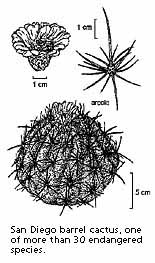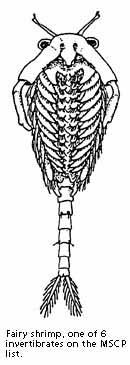






The results of work by the Multiple Species Conservation Program will
help decide the fate of 97 endangered species and between 85,000 and 200,000
acres of land in San Diego County. This critical project is almost unknown
by the general public. Not for much longer.
MSCP plans the future of conservation in San Diego
by Lori Saldaña
 n December 1993, an 1,800-page "working draft"
for an ambitious regional conservation program and ecosystem reserve for
San Diego County was finally unveiled. Called the San Diego Multiple Species
Conservation Program (or simply the MSCP), it was presented to the group
of people who have been guiding its creation since 1989 - a diverse blend
of conservationists, developers and representatives of public development
agencies.
n December 1993, an 1,800-page "working draft"
for an ambitious regional conservation program and ecosystem reserve for
San Diego County was finally unveiled. Called the San Diego Multiple Species
Conservation Program (or simply the MSCP), it was presented to the group
of people who have been guiding its creation since 1989 - a diverse blend
of conservationists, developers and representatives of public development
agencies.
 The imposing size of this draft document reflects the
scope of its two main goals. On one hand, it is an ambitious effort to protect
nearly 100 diverse species of wildlife, plants and insects native to San
Diego County. At the same time, it seeks to make enough land available to
local developers to meet the projected needs for housing and growth throughout
San Diego County for the next 20 to 50 years.
The imposing size of this draft document reflects the
scope of its two main goals. On one hand, it is an ambitious effort to protect
nearly 100 diverse species of wildlife, plants and insects native to San
Diego County. At the same time, it seeks to make enough land available to
local developers to meet the projected needs for housing and growth throughout
San Diego County for the next 20 to 50 years.
A clean start
 The impetus for this program was San Diego's ever-growing
demand for better water and sewage treatment utilities. To attempt to meet
these needs, the city of San Diego began a "Clean Water Program"
in 1989, and drafted plans to build facilities throughout the county to
improve services to its customers. The federal government required the city
to complete Environmental Impact Reviews (EIRs) of these projects, which
were then evaluated by the U.S. Fish and Wildlife Services Field Office
in Carlsbad.
The impetus for this program was San Diego's ever-growing
demand for better water and sewage treatment utilities. To attempt to meet
these needs, the city of San Diego began a "Clean Water Program"
in 1989, and drafted plans to build facilities throughout the county to
improve services to its customers. The federal government required the city
to complete Environmental Impact Reviews (EIRs) of these projects, which
were then evaluated by the U.S. Fish and Wildlife Services Field Office
in Carlsbad.
 After reviewing the plans, USFW concluded their environmental
impact would be so widespread that a county-wide mitigation program to offset
the effects of the development would be required. The "mitigation"
in this case was the creation of a comprehensive plan (the MSCP) to protect
the native plants, animals and insects that would be disrupted by the activities
of the water project itself, such as trenching, bulldozing, and building
construction.
After reviewing the plans, USFW concluded their environmental
impact would be so widespread that a county-wide mitigation program to offset
the effects of the development would be required. The "mitigation"
in this case was the creation of a comprehensive plan (the MSCP) to protect
the native plants, animals and insects that would be disrupted by the activities
of the water project itself, such as trenching, bulldozing, and building
construction.
Working group gets to work
 This led to the formation of the Multiple Species Conservation
Program Working Group. It is made up of people working on the Clean Water
Program, local planning and developmental agencies, members of conservation
and environmental organizations, and representatives from various cities
throughout San Diego County that share these water services with the city
of San Diego.
This led to the formation of the Multiple Species Conservation
Program Working Group. It is made up of people working on the Clean Water
Program, local planning and developmental agencies, members of conservation
and environmental organizations, and representatives from various cities
throughout San Diego County that share these water services with the city
of San Diego.
The first phase of the program, completed in 1993, was the creation of biological
resource maps for all of San Diego county. These are similar to the maps
Secretary of the Interior Bruce Babbitt wants to create as part of a nationwide
"biological survey." These maps show the location of many types
of existing vegetation and animal species. The maps will help planners create
a "network of potential wildlife preserves and connecting wildlife
corridors," according to an early description of the MSCP.
 The description also refers to the MSCP's second phase,
scheduled to begin this year, which involves "the acquisition of lands
and the establishment and operation of the wildlife preserve network planning
in phase one." However, exact estimates of the number of acres to be
acquired vary, ranging from 85,000 to 200,000 acres.
The description also refers to the MSCP's second phase,
scheduled to begin this year, which involves "the acquisition of lands
and the establishment and operation of the wildlife preserve network planning
in phase one." However, exact estimates of the number of acres to be
acquired vary, ranging from 85,000 to 200,000 acres.
How much protection?
 The working draft identified "core resource areas"
throughout the county that are essential for inclusion in the final reserve
design. It also offered four alternatives of varying levels of protection
for native wildlife and plant species.
The working draft identified "core resource areas"
throughout the county that are essential for inclusion in the final reserve
design. It also offered four alternatives of varying levels of protection
for native wildlife and plant species.
 According to Dan Silver, MSCP Working Group member and
coordinator of the Endangered Habitats League, "the most comprehensive
proposal provides Endangered Species Act-type protection for 61 plant and
animal species ranging from the California gnatcatcher to Gander's butterweed."
According to Dan Silver, MSCP Working Group member and
coordinator of the Endangered Habitats League, "the most comprehensive
proposal provides Endangered Species Act-type protection for 61 plant and
animal species ranging from the California gnatcatcher to Gander's butterweed."
Avoiding costly legal battles over the Federal Endangered Species Act (ESA)
is yet another goal of the MSCP. By creating a permanent reserve for native
species that are already listed or are in the process of being listed under
the ESA, it is estimated that the MSCP will save everyone money in the long
run.
 But Working Group member James Whalen is concerned that
the time involved with developing the final MSCP is yet another deterrent
to recovery for San Diego's beleaguered development industry. Whalen represents
the owners of some of the largest tracts of undeveloped land in western
San Diego county. As he sees it, "By trying to do so much up front,
we'll be shut down longer."
But Working Group member James Whalen is concerned that
the time involved with developing the final MSCP is yet another deterrent
to recovery for San Diego's beleaguered development industry. Whalen represents
the owners of some of the largest tracts of undeveloped land in western
San Diego county. As he sees it, "By trying to do so much up front,
we'll be shut down longer."
Silver doesn't agree, and notes that the working draft includes "an
economic comparison made between a comprehensive reserve and a "no
project" alternative. Assuming a fair share of state and federal funding,
the comprehensive approach results in greater personal income, lower housing
costs, and higher local sales and property tax revenues. Open space makes
sense!"
 While this final phase still must be decided, the program
to date represents three years of planning and nearly $3 million in operational
expense. It has forged an uneasy alliance between developers and conservationists,
but many battles remain, including one over an alternative included in the
final draft.
While this final phase still must be decided, the program
to date represents three years of planning and nearly $3 million in operational
expense. It has forged an uneasy alliance between developers and conservationists,
but many battles remain, including one over an alternative included in the
final draft.
 Called the "Public Lands" alternative, it
seeks to preserve development projects for a group of private property owners
whose lands may include prime California gnatcatcher habitat - already listed
under the ESA as a "threatened" species.
Called the "Public Lands" alternative, it
seeks to preserve development projects for a group of private property owners
whose lands may include prime California gnatcatcher habitat - already listed
under the ESA as a "threatened" species.
 Also being negotiated, are the details of purchasing
acquisitions. Who will pay? Developers? The Federal government? Taxpayers?
All of the above?
Also being negotiated, are the details of purchasing
acquisitions. Who will pay? Developers? The Federal government? Taxpayers?
All of the above?
These and other questions will be deferred to a new "MSCP Policy Committee,"
to be made up of elected officials from the various cities involved. At
some point in 1994, they will have the final say on which species, land
parcels and development plans become part of the first Multiple Species
Conservation Program ever created. And many people believe the eyes of the
nation will be watching to see if it succeeds.

Lori Saldaña is a writer, public speaker and photographer who
specializes in conservation and environmental issues.

In their own words ... interviews with MSCP working group members
Karen Scarborough
Karen Scarborough is assistant to the mayor of San Diego for public resources
and chairwoman of the MSCP Working Group. She joined the MSCP process in
July 1991. Prior to that she was chairwoman of the Open Space Committee
of Citizen's Coordinated for Century Three (C-3)
ET: Why were you invited to participate in the working group?
KS: I was asked to come on by Ann Van Leer in Ron Robert's office.
She thought the working group needed C-3's input. Sierra Club was also added,
several months after the process had begun. Up to that time it was city
departments and developers, without much environmental input.
Open space has always been my heartfelt interest. A regional open space
system - a balance of development on the land - has been a personal goal
of mine for many years.
I came from an understanding of how [development and conservation] can work
together. You're a steward of the land, your charge is to protect the land,
but accommodate human use of it, too. My professional background puts me
in the middle ground. As chair, I can relate to both sides, and see the
need for them to come together and relate as one.
ET: What has helped you be successful in this endeavor?
KS: It's the ability I seem to have to pull out a consensus from
a firestorm of discussion, making peace. I'm direct, and want people to
stay direct and not drift off.
ET: What questions remain to be answered before the MSCP goes to
the City Council?
KS: These are the biggies: How big is it going to be? How many species
is it going to cover? How much is it going to cost? Are we going to draw
lines? Where is it going to be? Am I in or out of it? How does it affect
me? . . .
 Developers don't want to get stuck with the bill. ...
All the taxpayers say you're crazy if you're going to raise taxes to pay
for this. But CalPAW '94 [a proposed bond initiative to purchase sensitive
lands throughout California] is out there - which could bring us some money.
AB 2007 is legislation to allow the county to do an open-space assessment
district, so that's another area where we might get some funds.
Developers don't want to get stuck with the bill. ...
All the taxpayers say you're crazy if you're going to raise taxes to pay
for this. But CalPAW '94 [a proposed bond initiative to purchase sensitive
lands throughout California] is out there - which could bring us some money.
AB 2007 is legislation to allow the county to do an open-space assessment
district, so that's another area where we might get some funds.
Dave Flesh
Dave Flesh is project manager of the MSCP. He has a background in Environmental
Research, Engineering and Economics. We asked him about the MSCP's history
since he was involved with the original Clean Water Program ElRs that led
to the creation of the MSCP.
ET: What areas are served by the MSCP?
DF: The program serves not only the city of San Diego but 11 cities
in the county, plus some of the unincorporated county. With a service area
that large we were really looking at a regional mitigation program from
the start.
ET: How was the working group created?
DF: They [U.S. Fish and Wildlife Service] felt for the plan to be
truly successful, it would be great to have input from other developers,
both public sector and private sector . . .
So we rounded up representatives from public sector developers and private
sector developers - private land developers. They brought in resource agencies
and representatives from a number of environmental and conservation groups
to sit around the table and help us with this plan. They also brought in
representatives from the cities within our service area that have the most
at stake - the largest amounts of remaining native vegetation.
 We brought in the county because of the substantial
amount of native vegetation that remains in the undeveloped, unincorporated
parts of the county.
We brought in the county because of the substantial
amount of native vegetation that remains in the undeveloped, unincorporated
parts of the county.
ET: Why is so much land involved in this project?
DF: To ultimately come up with a reserve system that would be of
sufficient size and contain sufficient habitat communities to preclude,
hopefully, the need to list any future species [as threatened or endangered]
well into the foreseeable future.
ET: What will this program mean for the nation?
DF: We think we're on the right track, that the rest of the country
will end up one way or another following our example. We've been told [by
Bruce Babbitt, secretary of the Department of the Interior] that we have
a model that's going to have national impact.
Michael Beck
Michael Beck is a San Diego County planning commissioner who also is
involved with the Multiple Habitat Conservation programs being developed
elsewhere in the county.
ET: Can you describe the scope and importance of this program?
MB: It's an opportunity to use this mandate. We have to create these
multiple-habitat reserves and address a multitude of quality-of-life issues
- they're all connected. We will never have a better opportunity for examining
these things.
 It seems that when we begin to address an issue as significant
as habitat planning, we generally lose sight of the corollary to the planning
effort. That is, when the reserves are designed, drawn out and ultimately
implemented - almost deductively - this will define other areas in the county
that will be appropriate for development . . .
It seems that when we begin to address an issue as significant
as habitat planning, we generally lose sight of the corollary to the planning
effort. That is, when the reserves are designed, drawn out and ultimately
implemented - almost deductively - this will define other areas in the county
that will be appropriate for development . . .
 There is an opportunity for the decision-makers in the
County to take this [MSCP] plan and coordinate it with other land-use planning,
quality-of-life issues such as urban limit lines and redevelopment. Not
redevelopment imposed on some jurisdiction just because we need to put the
density somewhere, but rather, some visionary sorts of redevelopment that
are geared toward transportation corridors and light rail systems - 21st
century thinking.
There is an opportunity for the decision-makers in the
County to take this [MSCP] plan and coordinate it with other land-use planning,
quality-of-life issues such as urban limit lines and redevelopment. Not
redevelopment imposed on some jurisdiction just because we need to put the
density somewhere, but rather, some visionary sorts of redevelopment that
are geared toward transportation corridors and light rail systems - 21st
century thinking.
Nancy Gilbert
Nancy Gilbert is a supervisory biologist for the U.S. Fish and Wildlife
Service at their Carlsbad field station. She has been involved with the
MSCP since 1989 when it first began as part of the mitigation process in
the Clean Water Program.
ET: What do you consider the most significant accomplishments
in this program so far?
NG: A very good land-use database for the region has been developed.
Overlaid with this is the development of the working group itself to pursue
a resolution of issues.
 I think the concept of regional planning has entered
the arena of something that needs to be done. And people are aware of it
as a concept. I think that's an accomplishment.
I think the concept of regional planning has entered
the arena of something that needs to be done. And people are aware of it
as a concept. I think that's an accomplishment.
ET: How do you see the role of community education at work?
NG: I think community involvement, education, and understanding the
concept is essential. Outreach should be occurring now, not waiting until
the plan is complete. The concept, the need, the benefits and the reality
of it should be up for discussion. Really, the whole process.
 For decades communities have recognized the value of
long-term planning. They plan for their community structure and character.
They plan and coordinate their jurisdiction for their infrastructure, roads
and sewer lines. But planning has never before occurred on a regional basis
for their biological resources.
For decades communities have recognized the value of
long-term planning. They plan for their community structure and character.
They plan and coordinate their jurisdiction for their infrastructure, roads
and sewer lines. But planning has never before occurred on a regional basis
for their biological resources.
ET: Will that make the MSCP hard for people to accept?
NG: It's never happened before. We have to play catch-up. We have
to address the fact that some of our resources, like vernal pools, are down
to their last 3 percent. Or down to their last 10 percent, like some of
our native grasslands. That makes it much more difficult than if we had
been planning over the past 20 years. It makes it harder to catch up on
any planning effort when it hasn't happened previously.
James Whalen
James Whalen is the vice-chairman of the MSCP Working Group, and chairman
of the Alliance for Habitat Conservation, an association of landowners formed
in 1989 to address endangered species issues in San Diego County. He is
a wildlife biologist by education who has been in the development business
for 10 years.
ET: What impacts are your organizations most concerned with?
JW: Economic impact; land use impact; the tax revenues that jurisdictions
may or may not have counted on; the cost of acquiring the land from landowners
who may or may not have development plans ... those sorts of thoughts are
getting to be better known.
 The building industry is there to provide all the necessary
economic overviews, not just on the construction industry. This is an important
part of the whole regional economic situation. Everyone thinks this is exclusively
a development issue, but it's not. It's an economic viability program for
the whole Southern California region.
The building industry is there to provide all the necessary
economic overviews, not just on the construction industry. This is an important
part of the whole regional economic situation. Everyone thinks this is exclusively
a development issue, but it's not. It's an economic viability program for
the whole Southern California region.
 If, for example, there are 300,000 vacant acres in the
MSCP proposed reserve area, two out of three of those vacant acres are considered
high or very high habitat value and go into the reserve. It would mean that
you wouldn't be able to come close to meeting the projected demand for housing
into 2015 according to SANDAG [San Diego Association of Governments]. And
that would be a big problem. If you could only accommodate 45 percent of
the housing you need because you have a large reserve system, then the reserve
is too big from one perspective. On the other hand, if it doesn't do the
job biologically, then it's too small.
If, for example, there are 300,000 vacant acres in the
MSCP proposed reserve area, two out of three of those vacant acres are considered
high or very high habitat value and go into the reserve. It would mean that
you wouldn't be able to come close to meeting the projected demand for housing
into 2015 according to SANDAG [San Diego Association of Governments]. And
that would be a big problem. If you could only accommodate 45 percent of
the housing you need because you have a large reserve system, then the reserve
is too big from one perspective. On the other hand, if it doesn't do the
job biologically, then it's too small.
ET: Is one of your concerns the number of species involved?
JW: Think of the complexity of trying to protect 94 different species
all at once. My position is to add those species that we know more about
- particularly the gnatcatcher - to get the habitat planning done for that,
and let the rest bring up the rear.
ET: When would you address these other species?
JW: Between two to seven years, not 40. It's our concern that by
trying to do so much up front we'll be shut down longer. Business in San
Diego is shut down today. With the gnatcatcher listed, you can't do anything
until that's addressed.
Dan Silver
Dan Silver, M.D., is coordinator of the Endangered Habitats League. His
work on protecting the Santa Rosa Plateau led to a successful drive to list
the California gnatcatcher as a threatened species. He serves as the EHL's
representative to the MSCP Working Group and the Implementation and Finance
Committee.
ET: What do you want people to know about the finances of this
plan?
DS: First of all, that it's going to be affordable. If the public's
shares are spread broadly, it will really have no measurable impact on people's
finances.
 Second, it will provide many long-term benefits for
the economy and the quality of life. I think it's a very wise investment
in the future and will be a real benefit to San Diego. It will hopefully
prevent future endangered species listings.
Second, it will provide many long-term benefits for
the economy and the quality of life. I think it's a very wise investment
in the future and will be a real benefit to San Diego. It will hopefully
prevent future endangered species listings.
ET: What is the role of the Implementation and Finance Committee?
DS: We're trying to figure out how to pay for land acquisition, what
the equity should be, and what the obligations of the local government,
public at large, federal and state governments and development community
are.
ET: Why is this program so important to the EHL?
DS: There's another very important conservation objective: to integrate
this habitat plan with better land use planning in general. That is, more
compact development, less sprawl. If we do that we'll avoid many problems
in the future.
ET: Some people would ask why we have to save every species. How
would you reply?
DS: Well, that's really a philosophical argument. I think every species
has a right to exist. But even those who don't agree with this concept do
agree that it makes economic sense to try to be pro-active. We must get
out in front of these endangered species listings so we don't have any more
disruption. So the MSCP Working Group has a consensus on the need to do
comprehensive multiple species planning, even though people may have different
reasons for it.
 My reasons may be different from the developers', but
nevertheless we do have a consensus on it. Although there are some extreme
elements in the development community who are trying very hard to obstruct
the process, I think they're more on the fringe.
My reasons may be different from the developers', but
nevertheless we do have a consensus on it. Although there are some extreme
elements in the development community who are trying very hard to obstruct
the process, I think they're more on the fringe.

Call to action - what you can do
 In the next step of the MSCP process, a special "policy
committee" will begin evaluating the options prsented in the working
draft. Sitting on this committee will be elected officials, listed below,
who will decide the final design of the MSCP, including: how much land will
be reserved, which species will be involved, and how will it be funded.
In the next step of the MSCP process, a special "policy
committee" will begin evaluating the options prsented in the working
draft. Sitting on this committee will be elected officials, listed below,
who will decide the final design of the MSCP, including: how much land will
be reserved, which species will be involved, and how will it be funded.
 To request more information, to stay informed of the
MSCP process, or to let the policy committee members know what you think
about MSCP, please write to:
To request more information, to stay informed of the
MSCP process, or to let the policy committee members know what you think
about MSCP, please write to:
Board of Supervisors
County of San Diego
1600 Pacific Highway, Room 335
San Diego, CA 92101
Mayor and City Council
City of Chula Cista
276 Fourth Avenue
Chula Vista, CA 91910
Mayor and City Council
City of Santee
10765 Woodside Avenue
Santee, CA 92071
Mayor and City Council
City of Poway
13325 Civic Center Drive
Poway, CA 92064
Mayor and City Council
City of San Diego
202 C Street, 11th floor
San Diego, CA 92101
Attn: Karen Scarborough










